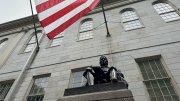In the wake of Harvard Management Company’s (HMC) reported 21.4 percent rate of return on the University’s endowment investments for the fiscal year ended June 30, and the increase in the value of the endowment to $32 billion, other schools are now reporting comparable—or even more robust—returns.
Yale today announced a 21.9 percent rate of return, increasing the value of its endowment to $19.4 billion from $16.7 billion a year earlier (after taking into account gifts received and funds disbursed to support the university’s operations). Yale’s 10-year rate of return, annualized, is now 10.1 percent. It reported the following results by asset class:
Domestic equity returned 24.5% for the fiscal year, underperforming the benchmark return by 7.8%. Foreign equity exceeded its benchmark by a margin of 12.5% with a return of 40.7%. Yale’s absolute return portfolio produced a 12.7% return, consistent with both expectations and past experience. Real assets, comprised of real estate and natural resources, returned 16.5% after two years of poor results. The University’s private equity portfolio rebounded from crisis-induced losses with a robust return of 30.3%.
(HMC’s rates of return by class, and longer-term performance figures, were reported previously. That report, and the Yale release, contain information on each portfolio’s asset allocations.) Significantly, Yale announced that it would begin modestly increasing spending from its endowment—a step Harvard has already been able to undertake for the current fiscal year.
MIT reported a 17.9 percent investment return and appreciation in its endowment’s value from $8.5 billion to $9.9 billion.
Duke reported a strong 24.5 percent investment return and a fiscal year-end endowment value of $5.7 billion.
Bloomberg reports that Cornell’s investment return, earlier estimated at about 17 percent, was 20 percent, bringing the endowment’s value to $5.35 billion. Penn’s reported return was 19 percent.
As reported earlier, Stanford’s large endowment realized a 22.4 percent return (raising its value at the end of August to $16.5 billion).
Princeton and the University of Virginia, which follow investing strategies similar to those of Harvard, Yale, and Stanford, have yet to be heard from.








